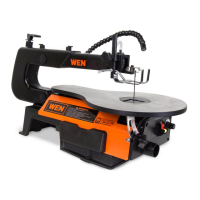14
BLADE REMOVAL AND INSTALLATION (Fig. 13 to 15)
WARNING: To prevent personal injury, always turn saw OFF and disconnect the plug from
the power source before changing blades or making adjustments.
This saw uses pin-end and pinless blades. Pin-end blades
are thicker for stability and for faster assembly. They pro-
vide faster cutting on a variety of materials.
Note: When installing pin-end blades, the slot on the
blade holder must be slightly wider than the thickness of
the blade. After the blade is installed, the blade tension
mechanism will keep it in place.
1. To remove the blade, loosen the tension on it by lifting
up and turning the blade tension lever (1) counterclock-
wise.
2. Remove the table insert. Carefully pry up on the table
insert to remove.
3. Loosen the upper blade holder knob (2) and lower blade
holder knob (3). Push down on the upper blade holder to
remove the blade from the holder. Remove the blade from
the lower blade holder.
CAUTION: Install the blade with the teeth pointing down-
ward.
4. To install the blade, hook the blade in the recess of the
lower blade holder.
5. While pushing down on the upper blade holder, insert
the blade into the slot of the holder.
6. Tighten the upper and lower blade holder screws.
7. Move the blade tension lever down and turn the blade
tension lever (1) clockwise until you feel the slack in the
blade removed. Make sure the blade is properly located in
the blade holders. Turn the blade tension knob an addition-
al full clockwise turn. This amount of blade pressure should
do well for most cutting operations.
8. Snap the table insert back into place.
ASSEMBLY AND ADJUSTMENTS
FIGURE 13
FIGURE 14
FIGURE 15

